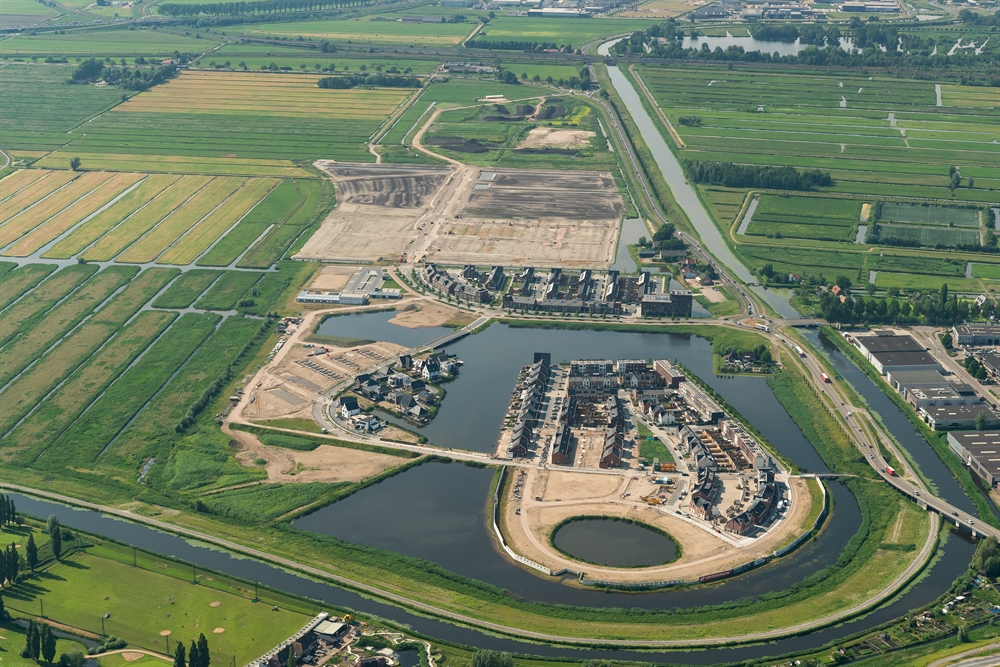Climate-adaptive neighbourhood of Westergouwe
On the west side of the city of Gouda, the new, watery residential area of “Westergouwe” is being developed. This area development is taking place at virtually the lowest point in all of the Netherlands: the Zuidplas polder. Gouda will thus have an entirely new neighbourhood, comprising 4000 houses and facilities. The Westergouwe project has been set up by the municipality of Gouda and the VolkerWessels Vastgoed / Heijmans Vastgoed real estate combination. Each of these parties is developing and constructing its own houses. Together, they will be constructing roads, water, and greenery. To this end, they have set up the Westergouwe Project Agency. Climate adaptation plays a major role in the area development, which leads to specific measures in the fields of flood risk management, water storage, and heat stress.

Image: Westergouwe planning area
Westergouwe: sustainable and climate-adaptive construction
The Westergouwe neighbourhood is being surrendered stage by stage; the project will run until approx. 2034. The first residents have already moved into their new houses. The neighbourhood will feature, among other things, three residential islands and a large green-blue zone. This green-blue zone is a nature and recreational area the size of some sixty football fields. Westergouwe has high ambitions in terms of sustainability. For example, a proportion of the houses will be realised on a natural gas-free and zero-on-the-meter basis, while the streets will be illuminated by LED lighting. The construction of the nature and recreational areas, ecological facilities, green axes, and wide watercourses with natural banks will enhance biodiversity, which will make the Westergouwe neighbourhood a pleasant area for both humans and wildlife. At the same time, all the water and greenery will serve to collect water during severe downpours, or in the event of a dyke giving way.
Climate-adaptive measures
With its vast watery and green spaces, Westergouwe is quite capable of coping with heavy rainfall. Downspouts are not connected to the sewer system; rainwater is collected in the big lake with residential islands, and in the nature and recreational area. The water is thus retained locally. After a few days, it is gradually drained towards the Zuidplas polder pumping station.
Before the site is cleared, the soil is consolidated by creating a so-called “sand freeboard” to have the soil set. This will reduce subsidence after construction and ensure that residents’ gardens will not continue to subside. Furthermore, the consolidation will raise the area’s infiltration capacity. Together with the large water storage capacity of the lake and the watercourses, this will create a water-resilient soil and water system.

Image: Green and blue in the streets (Photo: MKHNHT)
In addition, Westergouwe will have other facilities to improve its resilience even further against heat stress and deluges. Examples include the use of permeable pavement allowing rainwater infiltration in the soil and the realisation of lots of public green spaces, which will have a cooling effect during hot summer days.
Involvement of residents
In addition to measures in public spaces, the project endeavours to create awareness among residents in such areas as extreme rainfall, heat, and nature. This is achieved through encouragement and providing information. The point of departure is for residents to gain insight into the (major) contribution that their private gardens can make to the measures that have already been implemented in public spaces.
Green and blue to enhance spatial quality
Westergouwe will be a neighbourhood featuring a great deal of environmental greenery. The polder will – literally – encroach upon the neighbourhood: via the parks, the existing polder and the green-blue zone will extend into the neighbourhood. This means that nature will be close by to each of the houses. This greening will not only help to increase biodiversity and reduce heat stress; it will also enhance the quality of living and encourage interaction between residents and nature.

Image: residential island in Westergouwe (Photo: KOZZMOZZPHOTO)
Next steps
Westergouwe I (first phase) is nearing completion; almost all of the houses are occupied. Westergouwe II (second phase) has entered the ground-clearing phase, and houses will be available for sale in the autumn of 2018. Plan development for Westergouwe III (phase 3) has commenced.
Lessons to be learned from the project
- Close and constructive collaboration with regional water authorities is essential to get climate adaptation off the ground: collectively formulating the ambitions!
- In addition, all the parties that have initiated the Westergouwe project (VolkerWessels, Heijmans, and municipality of Gouda) acknowledge the importance, value, and necessity of implementing climate measures. Such climate measures are being “marketed” as quality and added value for real estate. They feature in the Westergouwe area promotion campaign and are regarded as positively distinctive factors.
- By labelling the measures “the new normal”, they are regarded as established facts rather than extras.
Contact
Projectbureau Westergouwe
info@westergouwe.nl
0182 52 76 83
